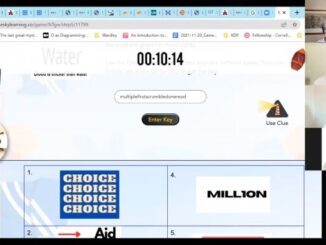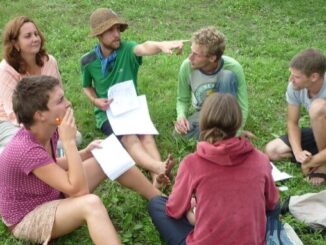
When I tweeted about how to fully involve and engage 100 people in a full day Zoom workshop, the first response was “a full day – on Zoom?”
We are all online on Zoom now. Yet too many events are pre-recorded webinars or slide based presentations. Stop! That is not how to excite and inspire people.
I’m pretty proud of the real-life conferences we hold, ensuring no speaker presents for longer than 9 minutes without involving the participants. But, of the recent two-dozen or so conferences we’ve held, this Zoom-based one detailed below was our 3rd highest ever for interaction and involvement and top for work relevance.
The secret was that it was teaching online Liberating Structures by getting everybody to use Liberating Structures.
What are Liberating Structures? They are a set of formalised techniques that, instead of having meetings dominated by one or two people, involve everybody.
We had offered the session free to NHS staff (and others battling the virus) so a large proportion of people there were health workers, but from trusts across the country. As well as participants from China, Iran, Kyrgyzstan, Egypt and more. Here are the structure we used:
Spiral Journal: A mindful start

Take a piece of A4 paper and fold it into 4. Spend two minutes drawing a spiral, as slowly and as tightly wound as possible, out from the centre. In response to four prompts, give your answers in each of the four quadrants. Then discuss in (breakout room) pairs.
This is a chance to reflect, and ground yourself. The prompts that we used were: “Right now my body is feeling……”, “The challenges I’m bringing with me to this workshop are……”, “Something I have been paying close attention to is………”, “Lately it’s been important for me to…..”
“Loving the space to talk about personal feelings in a professional space.”
“I liked being able to focus. Being present for yourself and everyone. Knowing what may be on people’s minds ahead of the day. Giving everyone a voice.”
“It is calming and helps to concentrate.”
Conversation Cafe: Going deeper
Conversation cafe is one of my favourite techniques when facilitating live. It gives a chance of everybody to contribute and, through successive rounds, think more deeply.
The key to the live event is to use a “talking object”, so you can only speak when you hold it. This avoids the way people want to jump in and often don’t listen as a result, and ensures every single person in the room has a voice.
There are four rounds, one for initial reflections on the prompt (in this case “what is emerging for you, your work and society in the current crisis?”), one for further thoughts, an open discussion (without the “talking object”) and then a round of what you are taking away.
How to take the talking object online? People were split into breakout rooms of 5 to 6, and all but the speaker muted their microphone. One the speaker finishes they say who will speak next and that person unmutes. It worked well.
“Brilliant way to enable everyone to share!”
“The impossible is possible. It just needs a powerful enough trigger.”
“It started light, and then we went quite deep and opened up a lot of convo.”
“We are all facing similar challenges but have very different perspectives.”
“Summing up at the end – take-aways – rather than leaving a meeting thinking ‘so what?’”
Mad Tea:
You form two circles, so everybody is facing another person. Prompts are presented and each person responds in turn in just 30 seconds. (eg, “The current crisis is making me feel ….” and “Things that are more important for me now are… “) Then one circle moves round and you face another person.
It is a high energy activity, giving a chance to meet people quickly. In Zoom, you display the prompt in Chat (and on Broadcast) and split the room into pairs for 90 seconds, sending out a broadcast at the half way point. It still produces a buzz:

“It was AWESOME ENERGIZING.”
“Truly mad.”
“Enables structured clear conversations.”
“Creates energy.”
“Ice breaker – meeting new people and creates a talking points.”
“I feel re-energised.”
“Could be used for random idea generation when you get stuck.”
“Very rapid but actually a good way to meet lots of people rapidly.”
Ecocycle Planning

Here you explore where your different activities are, or the different elements of a project. The first time I did it, I was troubled that my activities were all on the gestation and birth side. Now I’ve come to realise that is where my strengths are, and what I need to make sure to do is pass activities on to others on that path from birth to maturity.
“So much wisdom in these rooms!”
“The impact of Covid has put lots in either the poverty or rigidity trap – we have an opportunity to do some creative destruction and give birth to new things too!”
“Brilliant way to involve your team and educate others who may not be invested in a team’s work.”
“It’s a good way of finding out where on the cycle different people perceive the same thing to be.”
W3: What? So What? Now What?
W3 is a great way to reflect on a discussion or a process and step away from self-generating beliefs. It simply consists of asking three questions, each to be considered first alone and then in pairs, to reflect on a process or shared experience:
What? What did you see, feel, hear, think?
So What? What are the implications?
Now What? What to do next?
“It ensures we think beyond what happened and into its implications and action steps.”
“Active reflection. An opportunity to focus on what this activity meant and was useful for.”
“I already use W3 in my teaching and in prompts to write reflection… but maybe doing it in smaller groups is better than whole class.”
Triz: Whats the worst that could happen?
In Triz you look at the worst possible outcome (eg, what would make this project fail?). Working first alone and then in groups, you examine what could lead to that result. Then, again working first alone and then in groups, you explore which of those things your organisations is doing.
Our prompt was “how can you ensure you respond to this crisis in a way that is reliably disastrous for yourself and others”. There was a lot of talk of Trump and injecting Dettol, but also of issues like “failing to adapt”.
“It helps NHS staff who are used to risk avoidance to bridge the gap to fresh eyes.”
“Enables honesty and openness in a safe way.”
“Finding solutions to some wicked issues.”
“A safe way of surfacing behaviours that are not serving us well.”
“Psychological safety- gives people permission and space to be creative/wild which then leads to productive reflective action plans.”
124All: Rapid engagement of everybody
124All is, in real life, the most commonly used structure. If you are discussing a new topic or issue or problem, ask each person to reflect on their own for a minute. Then join them into pairs. Then join the pairs into fours. And then a general discussion. It ensures everybody gets to talk, including those who are more reflective.
Online, especially with 102 people, the move from pairs into fours is tough. It can be done as Host in Zoom Breakouts, and is fairly easy for less than 20 people, but it would take a long time for 100. So we randomised the move into fours. Opinion was split on whether this worked better or worse than keeping the pairs together when they went into fours.
“Allows for a range of views to be shared.”
“A real chance to be heard.”
Troika: Consultation in threes
What challenge or issue would you like help on? Troika groups three people together. Each in turn raises their issue and explains it to the others. In real life, they then turn their back (so the others can’t see their response and facial expression) and hear the other two discuss their issue for 5 minutes.
Online, you can turn your back. But for me it was actually more effective than normal to turn off my video and be able to not just hear my two colleagues but see them too. It is remarkable how often real insights result from this process:
“I am amazed by usefulness of feedback in such a SHORT time!!!!”
“I think Troika is awesome!”
“How did that magic happen???”
“I didn’t think it could be so powerful.”
“I will use Troika again in my team as it gives perspective and fresh thought to things considered impossible.”
Drawing Together:

Take a piece of paper and, using the five set symbols, answer the prompt. In this case: Tell the story of your learning journey today and what has been sparked in you as a facilitator. Then join a pair to have them interpret it.
“A sense of shapes and the shape of the day.”
“Really enjoyed that, was a powerful tool.”
“Adds a creative element to storytelling through each other’s eyes.”
“It was really helpful for me to reflect and go through the journey using pictures. I thought sharing was fun and it was interesting to hear the other people’s interpretation.”
“It helped me see where I started from this morning and where I am now at the end of the day.”
The Overall Verdict
This was a hugely engaging event, the opposite of so many Zoom-based conferences. Many of those attending found it transformational:
‘I feel liberated! Fresh insights. Like the anti-goal! Zoom functionality is great – didn’t realise!”
“Must have required a lot of prep from the hosts!” Mo
“It was a lovely event and although we connected remotely, we achieved great discussions. Thank you everyone” Evi
“Loved it loads, was feeling ill, now better” Fiona
“very interactive and dynamic, loved it, thank you” Tatev
“Super day – lots of new neural pathways!” Hannah
“enjoyed every bit of the day. Lots to explore further” Sophia
“It worked very well on Zoom. Feeling very energised and excited..” Al
“Lovely spending a day out of the Covid madness” Martyne
“One of the best things about LS is that it creates the opportunity — and expectation — to LISTEN ACTIVELY to others” Jeff
“Inspiring seeing how successful the tools are in a virtual environment” Sally
“This was immersive, and even though really intense and I had a headache half way, I enjoyed it a lot. Also meeting so many people” Angie
“Today has been knowledge filled and it was a wonderful day-thank you” Fidelia
“I’ve got lots of tools to use with my team and those who are attending our leadership training. I am really energised by this and thinking of all of the possibilities there are with these tools. It has been great to meet so many people virtually and see how you can use Zoom to make meetings much more interesting.” Rosie
“Excellent day, never used Zoom before. Thank you for a great learning day” Anne
“Such a wonderful day. Exhausted from so many brilliant ideas, tools and thoughts. 🙂 Lovely to meet everyone!” Jenny
“It’s really opened my eyes to all the possibilities of how we can work virtually but keep creativity.” Danni
‘I’ve got lots of tools to use with my team and those who are attending our leadership training. I am really energised by this and thinking of all of the possibilities there are with these tools. It has been great to meet so many people virtually and see how you can use Zoom to make meetings much more interesting.’ Rosie
Reflection
These structures require minimal facilitation. The role is to decide which structure is appropriate and which prompt to use. It brings me back to Lao Tzu’s statement:
“A leader (or teacher) is best when people barely know they exist, when their work is done, people will say: we did it ourselves.”
Acknowledgments and further reading:
This session was a joint enterprise. My co-facilitators were David Heath, Mikala Ritzau, Leah Lockhart & Lyse Edwards, who all did a fabulous job. And a huge thanks to my Happy colleague Natalie Salmon for organising the bookings and the event.
Want to find out more. Check out the Liberating Structures web site where all the 33 structures are clearly defined.
- Liberate your online meetings and events - 16th June 2020





Be the first to comment